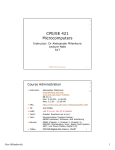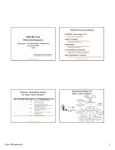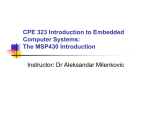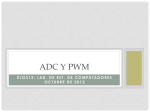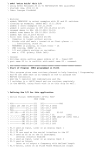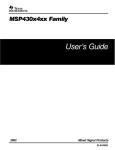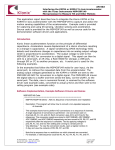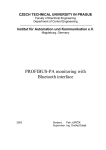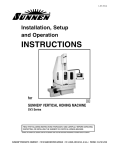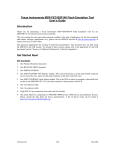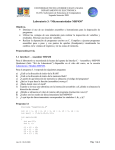Download Alex Milenkovich 1
Transcript
Aleksandar Milenkovic [email protected] www.ece.uah.edu/~milenka EB 217-L Mon. 5:30 PM – 6:30 PM, Wen. 12:30 – 13:30 PM ¾ URL: http://www.ece.uah.edu/~milenka/cpe421-05F CPE/EE 421 Microcomputers Instructor: Dr Aleksandar Milenkovic Lecture Note S17 Review: Digital I/O U A H 1 CPE/EE 421/521 Microcomputers all MSP430 Port1 Port2 Port3 … Port6 Function Select Register PxSEL yes yes Interrupt Edge Select Register PxIES yes no Interrupt Enable Register PxIE yes no Interrupt Flag Register PxIFG yes no Direction Register PxDIR yes yes Output Register PxOUT yes yes yes yes Input Register PxIN ¾ TA: Joel Wilder ¾ Labs: Lab #4 is on. Hw #2 is posted. ¾ Test I: Graded. Solutions are in scr/. ¾ Text: Microprocessor Systems Design: 68000 Hardware, Software, and Interfacing ¾ Review: M68K (Chapter 1; Chapter 2; Chapter 3), MSP430 (Introduction, Arch., Basic Clock System, WDT, Low Power Modes, Digital I/O) ¾ Today: CPE/EE 421/521 I/O, Microcomputers MSP430 Digital Timers, USART 2 Digital I/O Introduction ¾ MSP430 family – up to 6 digital I/O ports implemented, P1-P6 ¾ MSP430F14x – all 6 ports implemented Ports P1 and P2 have interrupt capability. Each interrupt for the P1 and P2 I/O lines can be individually enabled and configured to provide an interrupt on a rising edge or falling edge of an input signal. The digital I/O features include: P1. ¾ Independently programmable individual I/Os P2. P3. U A H ¾ Instructor: U A H U A H Course Administration 7 6 5 4 3 2 1 0 ¾ Any combination of input or output P4. ¾ Individually configurable P1 and P2 interrupts P5. ¾ Independent input and output data registers Chapter 9, User’s Manual pages 9-1 to 9-7 P6. The digital I/O is configured with user software CPE/EE 421/521 Microcomputers Digital I/O Registers Operation Input Register PnIN 4 U A H 3 U A H CPE/EE 421/521 Microcomputers Digital I/O Operation Direction Registers PnDIR Each bit in each PnIN register reflects the value of the input signal at the corresponding I/O pin when the pin is configured as I/O function. Do not write to PxIN. It will result Bit = 0: The input is low in increased current consumption Bit = 1: The input is high Bit = 0: The port pin is switched to input direction Bit = 1: The port pin is switched to output direction Function Select Registers PnSEL Output Registers PnOUT Port pins are often multiplexed with other peripheral module functions. Each bit in each PnOUT register is the value to be output on the corresponding I/O pin when the pin is configured as I/O function and output direction. Bit = 0: I/O Function is selected for the pin Bit = 1: Peripheral module function is selected for the pin Bit = 0: The output is low Bit = 1: The output is high CPE/EE 421/521 Microcomputers Alex Milenkovich 5 CPE/EE 421/521 Microcomputers 6 1 Timer_A MSP430x1xx ¾ Purpose The Timer A and B systems on the MSP are a versatile means to measure time intervals. The timers can measure the timing on incoming signals or control the timing on outgoing signals. This function is necessary to meet arbitrary timing requirements from outside components, and the ability is useful in phase locking scenarios Interrupt Flag Registers P1IFG, P2IFG (only for P1 and P2) Bit = 0: No interrupt is pending U A H U A H Digital I/O Operation ¾ Features 16-bit counter with 4 operating modes Selectable and configurable clock sources (internal - ACLK, SMCLK; external – INCLK, TBCLK) Three (or five) independently configurable capture/compare registers with configurable inputs Three (or five) individually configurable output modules with 8 output modes Multiple, simultaneous, timings; multiple capture/compares; multiple output waveforms such as PWM signals; and any combination of these. Interrupt capabilities Bit = 1: An interrupt is pending (Only transitions, not static levels, cause interrupts) Interrupt Edge Select Registers P1IES, P2IES (only for P1 and P2) Each PnIES bit selects the interrupt edge for the corresponding I/O pin. Bit = 0: The PnIFGx flag is set with a low-to-high transition Bit = 1: The PnIFGx flag is set with a high-to-low transition • each capture/compare block individually configurable U A H Timer_A3 8 CPE/EE 421/521 Microcomputers U A H 7 CPE/EE 421/521 Microcomputers Timer_A5 - MSP430x1xx Block Diagram Page 11-3, User’s Manual 9 ¾ What is a capture? A record of the timer count when a specific event occurs. The capture modules of the timers are tied to external pins of the MSP. When the control registers of timer A and the specific capture compare module have been properly configured, then the capture will record the count in the timer when the pin in question makes a specific transition (either from low to high or any transition). This capturing event can be used to trigger an interrupt so that the data can be processed before the next event. In combination with the rollover interrupt on Capture module 0, you can measure intervals longer than 1 cycle. ¾ Compare CPE/EE 421/521 Microcomputers Alex Milenkovich Timer_A Counting Modes UP/DOWN Mode Stop/Halt Mode Timer counts between 0 and CCR0 and 0 Timer is halted with the next +CLK 0FFFFh 11 UP/DOWN Mode CCR0 0h UP Mode Continuous Mode Timer counts between 0 and CCR0 The inverse of a capture. While capture mode is used to measure the time of an incoming pulse width modulation signal (a signal whose information is encoded by the time variation between signal edges), compare mode is used to generate a pulse width modulation (PWM) signal. When the timer reaches the value in a compare register, the module will give an interrupt and change the state of an output according to the other mode bits. By updating the compare register numbers, you change the timing of the signal level transitions. U A H Capture and Compare Registers 10 CPE/EE 421/521 Microcomputers U A H CPE/EE 421/521 Microcomputers Timer continuously counts up 0FFFFh Continuous Mode 0FFFFh CCR0 0h 0h CPE/EE 421/521 Microcomputers 12 2 Timer_A Capture Compare Blocks Timer Clock CCMx0 0 Disabled 1 Pos. Edge 0 Neg. Edge 1 Both Edges SCSx 15 160h rw(0) rw(0) rw(0) rw(0) rw(0) rw(0) rw(0) Input Divider rw(0) rw(0) SSEL1 SSEL0 0 0 0 1 1 0 1 1 Page 11-12, User’s Manual Mode Control rw(0) ID1 ID0 0 0 1 1 0 1 0 1 rw(0) rw(0) MC1 MC0 0 0 1 1 rw(0) (w)(0) rw(0) 1 Compare Path Stop Mode Up Mode Continuous Mode Up/Down Mode CCRx 0172h to 017Eh 1/1, Pass 1/2 1/4 1/8 CCTLx 162h to 16Eh TACLK ACLK MCLK INCLK OUTx (CCTLx.2) Output D SCCIx 2 0 15 2 rw(0) rw(0) CAPTURE MODE rw(0) rw(0) rw(0) INPUT SELECT rw(0) 13 rw(0) rw(0) rw(0) rw(0) rw(0) SCS SCCI unCAP used rw(0) rw(0) rw(0) rw(0) rw(0) rw(0) rw(0) OUTMODx rw(0) rw(0) rw(0) rw(0) rw(0) rw(0) rw(0) 0 rw(0) 0 CCIE CCI OUT COV CCIFG rw(0) rw(0) r rw(0) rw(0) 14 CPE/EE 421/521 Microcomputers U A H TAx Logic EQU0 Set_CCIFGx Y 15 rw(0) 15 Timer_A Output Units EQUx EN A CCIx 0 1 0 1 CAPx EQUx 0 rw(0) CPE/EE 421/521 Microcomputers Timer Clock 0 Comparator to Port0x unTAIE TAIFG used CLR U A H Input Select unused 0 Capture/Compare Register CCRx Capture 0 Synchronize Capture 0 TACTL Timer Bus Data Bus 15 1 Capture Mode CCMx1 0 0 1 1 15 Overflow x COVx Logic Capture Path CMPx CCISx1 CCISx0 0 1 2 3 CCIxA CCIxB GND VCC U A H U A H Timer_A 16-bit Counter Timer_A Continuous-Mode Example 0FFFh Output Signal Outx Set Q To Output Logic TAx Timer Clock 0h Reset POR CCR0: Capture Mode: Positive Edge Px.y TA1 Input CCR1: Capture Mode: Both Edges Px.z TA2 Input CCR2: Capture Mode: Negative Edge OUTx OMx2 OMx1 OMx0 OMx2 OMx1 OMx0 Function TA0 Input Operational Conditions 0 0 0 Output Mode Outx signal is set according to Outx bit 0 0 1 Set EQUx sets Outx signal clock synchronous with timer clock 0 1 0 PWM Toggle/Reset EQUx toggles Outx signal, reset with EQU0, clock sync. with timer clock 0 1 1 PWM Set/Reset EQUx sets Outx signal, reset with EQU0, clock synchronous with timer clock 1 0 0 Toggle EQUx toggles Outx signal, clock synchronous with timer clock 1 0 1 Reset EQUx resets Outx signal clock synchronous with timer clock 1 1 0 PWM Toggle/Reset EQUx toggles Outx signal, set with EQU0, clock synchronous with timer clock 1 1 1 PWM Set/Reset EQUx resets Outx signal, set with EQU0, clock synchronous with timer clock CCR0 CCR1 CCR1 CCR1 CCR1 Interrupts can be generated CCR2 Example shows three independent HW event captures. CCRx “stamps” time of event - Continuous-Mode is ideal. 15 Timer_A PWM Up-Mode Example 0FFFFh 16 CPE/EE 421/521 Microcomputers U A H CPE/EE 421/521 Microcomputers CCR0 CCR1 CCR1 U A H Output Mode 0 Px.x Timer_A PWM Up/Down Mode Example 0FFFFh thlfper CCR0 CCR2 CCR0 CCR1 CCR1 CCR2 0h CCR3 0h TA1 Output CCR1: PWM Set/Reset Px.x TA1 Output 0 Degrees (0.5xVmotor) CCR2: PWM Reset/Set Px.x tpw1 TA2 Output Px.y TA2 Output +120 Degrees CCR0: PWM Toggle Auto Re-load tpw2 (0.93xVmotor) TA0 Output Px.y Px.z EQU2 EQU0 EQU2 EQU1 EQU0 EQU1 tpw3 -120 Degrees EQU2 EQU0 Interrupts can be generated TA0 Output Px.z (0.07xVmotor) TIMOV EQU0 TIMOV EQU0 TIMOV Interrupts can be generated Output Mode 4: PWM Toggle Example shows three different asymmetric PWM-Timings generated with the Up-Mode CPE/EE 421/521 Microcomputers Alex Milenkovich Example shows Symmetric PWM Generation Digital Motor Control 17 CPE/EE 421/521 Microcomputers 18 3 U A H C Examples //*************************************************************** #include <msp430x14x.h> // MSP-FET430P140 Demo - Timer_A Toggle P1.0, // CCR0 Contmode ISR, DCO SMCLK // Description; Toggle P1.0 using software and TA_0 ISR. Toggle rate is void main(void) // set at 50000 DCO/SMCLK cycles. Default DCO frequency used for TACLK. { // Durring the TA_0 ISR P0.1 is toggled and 50000 clock cycles are added to // CCR0. TA_0 ISR is triggered exactly 50000 cycles. CPU is normally off and // used only durring TA_ISR. // ACLK = n/a, MCLK = SMCLK = TACLK = DCO~ 800k WDTCTL = WDTPW + WDTHOLD; // Stop WDT P1DIR |= 0x01; // P1.0 output CCTL0 = CCIE; Serial Communication // CCR0 interrupt enabled CCR0 = 50000; TACTL = TASSEL_2 + MC_2; // SMCLK, contmode // // // MSP430F149 _BIS_SR(LPM0_bits + GIE); // Enter LPM0 w/ interrupt // --------------- // /|\| // | | // --|RST // | // | } XIN|| XOUT|- // Timer A0 interrupt service routine | interrupt[TIMERA0_VECTOR] void TimerA(void) P1.0|-->LED { // P1OUT ^= 0x01; // Toggle P1.0 // M. Buccini // Texas Instruments, Inc // September 2003 // Built with IAR Embedded Workbench Version: 1.26B // December 2003 // Updated for IAR Embedded Workbench Version: 2.21B CCR0 += 50000; // Add Offset to CCR0 } //********************************************************************** U A H Serial I/O Interface Functional Units U A H 19 CPE/EE 421/521 Microcomputers Asynchronous Serial Interface ¾ Asynchronous Transmitted and received data are not synchronized over any extended period No synchronization between receiver and transmitter clocks ¾ Serial Usually character oriented Data stream divided into individual bits at the transmitter side Individual bits are grouped into characters at the receiving side ¾ Information is usually transmitted as ASCII-encoded characters 7 or 8 bits of information plus control bits CPE/EE 421/521 Microcomputers 21 Asynchronous Serial Interface, cont’d ¾ MARK level (or OFF, or 1-state, or 1-level) This is also the idle state (before the transfer begins) ¾ SPACE level (or ON, or 0-state, or 0-level) ¾ One character: Alex Milenkovich 22 Asynchronous Serial Interface, cont’d ¾ 12 possible basic formats: 7 or 8 bits of data Odd, even, or no parity 1 or 2 stop bits Others exist also: no stop bits, 4/5/6 data bits, 1.5 stop bits, etc. Start bit: space level Data bits Optional parity bit Optional stop bit CPE/EE 421/521 Microcomputers CPE/EE 421/521 Microcomputers U A H Translates the TTLlevel signals processed by the ACIA into a form suitable for the transmission path U A H Translates data between the internal computer form and the form in which it is transmitted over the data link Least significant bit 23 CPE/EE 421/521 Microcomputers 24 4 U A H U A H Receiver Clock Timing RS-232 Interface Standard ¾ Bi-polar: +3 to +12V (ON, 0-state, or SPACE condition) -3 to –12V (OFF, 1-state, or MARK condition) ¾ Modern computers accept 0V as MARK ¾ “Dead area” between –3V and 3V is designed to absorb line noise ¾ Originally developed as a standard for communication between computer equipment and modems ¾ For N=9 bits (7 data + parity + stop) maximum tolerable error is 5% (assume that the receiver clock is slow -- [T + δt] instead of T) T/2 > (2N+1)δt/2 ¾ From the point of view of this standard: MODEM: data communications equipment (DCE) Computer equipment: data terminal equipment (DTE) ¾ Therefore, RS-232C was intended for DTE-DCE links (not for DTE-DTE links, as it is frequently used now) δt/2 < 1/(2N+1) δt/T < 100/(2N+1) as a percentage RS-232 Interface Standard ¾ Each manufacturer may choose to implement only a subset of functions defined by this standard 26 CPE/EE 421/521 Microcomputers U A H 25 U A H CPE/EE 421/521 Microcomputers RS-232 Interface Standard, another example ¾ Two widely used connectors: DB-9 and DB-25 ¾ Three types of link Simplex Half-duplex Full-duplex ¾ Basic control signals RTS (Request to send): DTE indicates to the DCE that it wants to send data CTS (Clear to send): DCE indicates that it is ready to receive data DSR (Data set ready): indication from the DCE (i.e., the modem) that it is on DTR (Data terminal ready): indication from the DTE that it is on RS-232 Interface Standard ¾ DB-25 connector is described in the book; let’s take a look at DB-9 RS-232 Interface Standard Example: 9 to 25 pin cable layout for asynchronous data Signal 9-pin DTE 25-pin DCE Carrier Detect CD 1 8 from Modem Receive Data RD 2 3 from Modem Transmit Data TD 3 2 from Terminal/Computer Data Terminal Ready DTR 4 20 from Terminal/Computer Signal Ground SG 5 7 from Modem Data Set Ready DSR 6 6 from Modem Request to Send RTS 7 4 from Terminal/Computer Clear to Send CTS 8 5 from Modem Ring Indicator RI 9 22 from Modem Description CPE/EE 421/521 Microcomputers Alex Milenkovich 29 28 CPE/EE 421/521 Microcomputers U A H 27 U A H CPE/EE 421/521 Microcomputers DTR (Data terminal ready): indication from the DTE that it is on CPE/EE 421/521 Microcomputers Source DTE or DEC 30 5 DCE 2 2 3 3 7 7 7 7 DTE 3 7 7 RTS CTS 2 7 U A H 32 Handshaking Between RTS and CTS RxD TxD CTS RTS DTE 2 3 7 4 5 2 3 7 4 5 3 7 CPE/EE 421/521 Microcomputers TxD RxD RTS CTS 33 CPE/EE 421/521 Microcomputers Null Modem ¾ Null-modem simulates a DTE-DCE-DCE-DTE circuit 34 USART Peripheral Interface ¾ Universal Synchronous/Asynchronous Receive/Transmit (USART) peripheral interface supports two modes U A H TxD RxD DCE 2 3 7 4 5 DTE to DTE with remote control DTE 3 CPE/EE 421/521 Microcomputers U A H 2 3 7 4 5 DTE 2 31 DTE to DCE with remote control DTE DTE to DTE in full-duplex mode DTE DTE to DTE in simplex mode 2 The Minimal RS-232 Function RTS CTS DCE 2 CPE/EE 421/521 Microcomputers TxD RxD DTE to DCE in full-duplex mode DTE 2 DTE U A H DTE to DCE in simplex mode DTE The Minimal RS-232 Function U A H U A H The Minimal RS-232 Function Asynchronous UART mode (User manual, Ch. 13) Synchronous Peripheral Interface, SPI mode (User manual, Ch. 14) ¾ UART mode: Transmit/receive characters at a bit rate asynchronous to another device Connects to an external system via two external pins URXD and UTXD (P3.4, P3.5) Timing is based on selected baud rate (both transmit and receive use the same baud rate) CPE/EE 421/521 Microcomputers Alex Milenkovich 35 CPE/EE 421/521 Microcomputers 36 6 ¾ 7- or 8-bit data width; odd, even, or non-parity U A H U A H UART Features USART Block Diagram: UART mode ¾ Independent transmit and receive shift reg. ¾ Separate transmit and receive buffer registers ¾ LSB-first data transmit and receive ¾ Built-in idle-line and address-bit communication protocols for multiprocessor systems ¾ Receiver start-edge detection for auto-wake up from LPMx modes ¾ Programmable baud rate with modulation for fractional baud rate support ¾ Status flags for error detection ¾ Independent interrupt capability for transmit and receive 37 Initialization Sequence & Character Format ¾ Initialization Sequence CPE/EE 421/521 Microcomputers 38 U A H CPE/EE 421/521 Microcomputers Set SWRST bit Initialize all USART registers with SWRST = 1 Enable USART module via the MEx SFRs (URXEx and/or UTXEx) Clear SWRST via software (releases the USART for operation) Optional: enable interrupts vie IEx SFRs ¾ Character format CPE/EE 421/521 Microcomputers Alex Milenkovich 39 7







